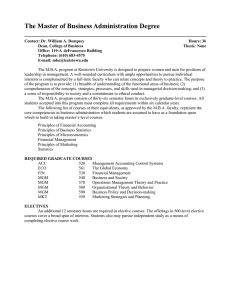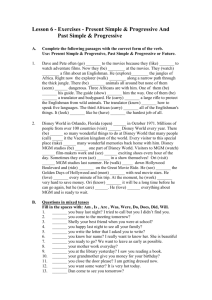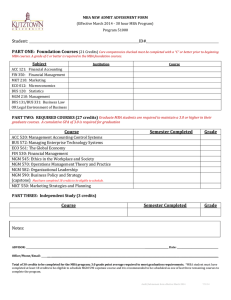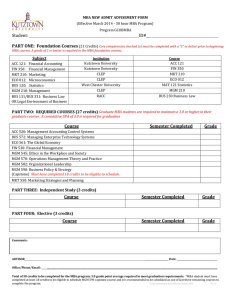Magnetic field extrapolations: Hands-on session Gherardo Valori 4
advertisement
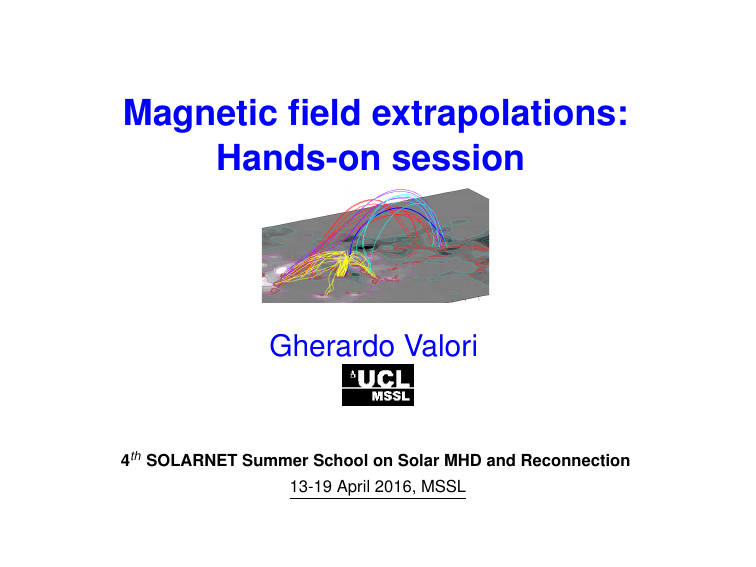
Magnetic field extrapolations: Hands-on session Gherardo Valori 4th SOLARNET Summer School on Solar MHD and Reconnection 13-19 April 2016, MSSL 1. How to GREEN STICKER: gotcha, go on! RED STICKER: no luck, help needed Let’s give it a try: 1 Open an IDL-SSW session 2 Point the variable maindir to your /your_path_to/FFF_hands_on/ maindir="/your/path/to/FFF_hands_on/" !path=maindir+"scripts:"+!path is_path_ok 3 Set IDL path to the script folder 4 Check the path: got a ’yes’? To follow the session copy and paste commands onto the IDL-SSW session / browser • from extrapolation_hands_on.idl (check slide reference number for relevant section) • from your copy of these slides Requires: IDL, SolarSoft/HMI, Paraview, and the FFF_extrapolation tree of the school’s data 2. Solar Monitor X1 Flare event on SOL2014-03-29T17:48 - Go to Solar Monitor http://www.solarmonitor.org/index.php? - Browse to date http://www.solarmonitor.org/index.php? date=20140329 - Check list events: X1 class flare was observed from NOAA AR12017 located at N10W32 (503",259") - Have a look at the different images and info, e.g., GOES SXR 3. SDO/HMI/SHARP For this session we use the so-called SHARP data series from Solar Dynamic Observatory / Helioseismic and Magnetic Imager http://hmi.stanford.edu/ Wikipedia example of CEA SHARP is the simplest one (Bobra et al., 2014) - 720 sec averaged SP measurements - Inversion using VFISV with Milne-Eddington model of the solar atmosphere (Borrero et al., 2011) - Cylindrical-Equal-Area projection (pixel size = 0.03 deg ' 0.5” at disk center) (Sun,X. arXiv:1309.2392v1) http://jsoc.stanford.edu/jsocwiki/ VectorMagneticField - 180deg ambiguity resolved by Minimum Energy Code (Leka et al., 2009). We need the HARP number corresponding to AR12017 on 2014 March 29. Use the catalogue http://jsoc.stanford.edu/doc/data/hmi/harp/harp_ definitive/2014/03/29/harp.2014.03.29_18:00:00_TAI.png And the HARP number is .... Note that is an AR complex rather than a single one! 4. JSOC download http://jsoc.stanford.edu/ajax/lookdata.html - On Tab: Series select - Click on ’Fetch seriesname list’ - Select ’hmi.sharp_cea_720s’, the next tab (Series Content) opens automatically - On Tab: Series Content - Spun ’Check box to show the ’QueryBuilder’ to learn how the request is built, e.g., fill in the HARP number - Fill in ’hmi.sharp_cea_720s[3894][2014.03.29_00:00:00_TAI/2h]’ for two hours data at full-time cadence of 12 minutes - Click on ’GetRecordCount’ to know how many records you have selected - Select ’All’ in Keywords: information about data and processing - Select ’Bp, ’Bt’, ’Br’ in Segments: which data are actually required for each record - Click on ’Fetch Keywords Values for RecordSet’, the next tab (Values display) opens automatically For additional details refer to https://www.lmsal.com/sdodocs/doc/dcur/SDOD0060.zip/zip/entry/ 4. JSOC download http://jsoc.stanford.edu/ajax/lookdata.html - On Tab: ’Values display’ - A summary of the chosen content is shown - click ’Export’ to open the ’Export window’ - On ’Export window’ - Select ’url-tar’ for fetching a single compressed file - Fill in a Requestor name and email - Click ’Check param for export’ - if all fine, click the -now green- ’Submit Export Request’ - The ’Submit statue request’ and an email tell you when the file is ready to be downloaded For additional details refer to https://www.lmsal.com/sdodocs/doc/dcur/SDOD0060.zip/zip/entry/ 4. JSOC download http://www.lmsal.com/solarsoft/jsoc/ssw_jsoc_routines.html One can use directly SSW, but instructions are a bit cryptic ; ; ; ser=ssw_jsoc(/SHOW_SERIES,filter=’hmi.sharp_cea_720s’) serstr=ssw_jsoc(/SERIES_STRUCT,DS=ser.names(1).name) exp_request=ssw_jsoc(/EXPORT,serstr=serstr,ds=serstr. interval.lastrecord,method=’url_quick’) Here, we use a local copy datadir =maindir+ "data/fits/" hmifile ="hmi.sharp_cea_720s.3894.20140329_013600_TAI." filenm =datadir+hmifile+["Br","Bp","Bt"]+".fits" read_sdo, filenm ,index,data ;where fits are ;CHANGE TO PREFLARE ;Add suffix array ;use SSW reading routines - index contains information about the observation - data contains the field components in the loaded order help,index,data,/struct 5. Build vmgm Extract essential infos from index nx=(index.naxis1)[0] ny=(index.naxis2)[0] dx=(index.cdelt1)[0] dy=(index.cdelt2)[0] ixcen=(index.crpix1)[0] iycen=(index.crpix2)[0] xcen=(index.crval1)[0] ycen=(index.crval2)[0] units="CEA-deg" ;The grid is uniform in the ; CEA reference system ;Pixel size in CEA-deg ;Pixel size in CEA-deg ;index x central pixel in CEA-deg ;index y central pixel in CEA-deg ;coord x central pixel in CEA-deg ;coord y central pixel in CEA-deg ;CEA degrees ;Build axes x_mgm=fltarr(nx) & for i=0,nx-1 do x_mgm[i]=xcen+ (-ixcen)*dx + i*dx y_mgm=fltarr(ny) & for i=0,ny-1 do y_mgm[i]=ycen+ (-iycen)*dy + i*dy ... and field. Note the sign of By Panic button: b_mgm=fltarr(nx,ny,3) b_mgm[*,*,2]= data[*,*,0] b_mgm[*,*,1]=-data[*,*,2] b_mgm[*,*,0]= data[*,*,1] ;Br= Bz ;Bt=-By ;Bp= Bx Build axes ... As of Eq.14 of X.Sun 2013 arXiv:1309.2392v1 restore, maindir+ "data/one_vmgm.sav",/v 5. Plot vmgm sizesym=2.5 & sizechar=2.5 & linethick=3. & thickchar=1.5 ;Set line/character size ixmin=0 & ixmax=nx-1 & iymin=0 & iymax=ny-1 ;Field of view to plot ywind=1000 ;Vertical window extension ar=(0.75-0.15)/(0.95-0.15)*float(ixmax-ixmin-1)/float(iymax-iymin-1) ;Set plot aspect ratio xwind=fix(ywind*ar) window,1,xsize=xwind,ysize=ywind, /free ;create window then plot cont_vecmgm,b_mgm[ixmin:ixmax,iymin:iymax,0], b_mgm[ixmin:ixmax,iymin:iymax,1],$ b_mgm[ixmin:ixmax,iymin:iymax,2], xaxis=x_mgm[ixmin:ixmax],yaxis=y_mgm[iymin:iymax],$ shrink=0.15,drawbar=1, sizechar=sizechar,thickchar=thickchar,ctini=1,ctend=254,$ nlevcont=40, neutral=0, skiptrbelow=50, skiplosbelow=50, units=units,colortb=0,$ arrlen=3,barsim=500 Use the cont_vecmgm procedure to draw isocontours of Bz and arrows for the horizontal field Try changing • • • shrink / arrlen : change number /length of arrows neutral =0/1 do not / do draw PIL of Bz skiptrbelow do not draw arrow if the field is below a given threshold Refer to routines’ headers in ./scripts for additional explanations 5. Vertical current density jz_mgm=0.5*((shift(b_mgm[*,*,1],-1, 0)-shift(b_mgm[*,*,1],1, 0))/dx+$ (shift(b_mgm[*,*,0], 0,-1)-shift(b_mgm[*,*,0],0,-1))/dy) window,1, xsize=xwind,ysize=ywind,/free cont_field_isoline,jz_mgm[ixmin:ixmax,iymin:iymax]/max(abs(jz_mgm)),$ b_mgm[ixmin:ixmax,iymin:iymax],$ xaxis=x_mgm[ixmin:ixmax],yaxis=y_mgm[iymin:iymax],drawbar=1,$ sizechar=sizechar,thickchar=thickchar,drawnl=0,$ isonlevcont=5,leviso=[-800.,-200.,200.,800.],conthick=2,colortb=3,barmax=0.5,barmin=-0.5 • • • Define Jz = ∂x By − ∂y Bx Draw isocontours of Jz with ±200G and ±800G reference isolines of Bz cont_field_isoline has similar keywords as cont_vecmgm Refer to routines’ headers in ./scripts for additional explanations 5. Force-free parameter alpha=fltarr(nx,ny) thresh=0.05 ;Set a threshold on Bz to avoid zeroes bz_mgm=b_mgm[*,*,2] ind=where(abs(bz_mgm) ge thresh*max(abs(bz_mgm)),cnt) alpha[ind]=jz_mgm[ind]/bz_mgm[ind]*(0.03/0.73)^2 ;Convert to approx 1/Mm skip=4 ;Remove edge values alpha[0:skip-1,*]=0. & alpha[nx-skip-1:nx-1,*]=0 alpha[*,0:skip-1]=0. & alpha[*,ny-skip-1:ny-1]=0. window,1,xsize=xwind,ysize=ywind, /free ;create window then plot cont_field_isoline,alpha[ixmin:ixmax,iymin:iymax],bz_mgm[ixmin:ixmax,iymin:iymax],$ xaxis=x_mgm[ixmin:ixmax],yaxis=y_mgm[iymin:iymax],drawbar=1,$ sizechar=sizechar,thickchar=thickchar,nlevcont=10,drawnl=0,$ isonlevcont=5,leviso=[-800.,-200.,200.,800.],conthick=1,colortb=3,barmax=0.01,barmin=-0.01 • • • Define α = Jz /Bz with a threshold on Bz to avoid small values Draw isocontours of α with ±200G and ±800G reference isolines of Bz Again cont_field_isoline Refer to routines’ headers in ./scripts for additional explanations 5. Forces on the mgm Looking at Lorentz forces on the mgm, e.g., epsfor, b_mgm, x_mgm, y_mgm, $ ef,fnorm, flux=flux,/verbose R Fx = − • • • mgm Bx Bz dxdy R 1 2 2 2 (B x + Bx + Bz ) 2 mgm epsfor takes mgm and axes in input fnorm[3] are normalized force components R flux = half unsigned flux = 0.5 |Bz | dxdy dxdy 6 Time evolution Let’s repeat for the whole time series by combining previous routines • • • load_fits load all fits in datadir and return a 4D array of [nx, ny , 3, nframes] frametime is some string label based on filenames for time stamp datadir =maindir+ "data/fits/" nn=long([ixmax-ixmin+1,iymax-iymin+1]) load_fits, datadir,ixmin,iymin,nn,x_mgm,y_mgm,$ units,b_mgm,frametime 1.5 days at 12 min cadence mvname="movie_vmgm" ;Name your movie outdir=maindir+"data/" ;Where to save it tmpdir=maindir+"data/tmp/" ;tmp directory vmgm2mp4, datadir,outdir,mvname,x_mgm,y_mgm,b_mgm,$ tmpdir=tmpdir, keep_png=0,units=units,srk=0.1,$ arrlen=2.5,pil=0,sizechar=3,ywind=900,$ label=frametime • • • Use vmgm2mp4 to produce the png of the frames If you are on linux -wise guy- and you have ffmpeg installed, you can try to build the movie (keep_png=0 and overwrite) If not, set keep_png=1 to save png images and merge them later A copy is saved in ./data/movie_vmgm.mp4 6 Time evolution Plot flux and forces in time • • Cycle over all snapshots Store forces in force_t[4,nframes] and flux in flux_t[nframes] nframes=(size(b_mgm))[4] time= make_array(nframes,/index)*0.20 ;Time [h] from start series ef_t= fltarr(4,nframes) force_t= fltarr(3,nframes) flux_t = fltarr(nframes) for iframe=0,nframes-1 do begin &$ epsfor,b_mgm[ixmin:ixmax,iymin:iymax,*,iframe],$ x_mgm[ixmin:ixmax],y_mgm[iymin:iymax],ef,force, flux=flux,verbose=0 &$ ef_t[0:3,iframe]=ef[*] & force_t[*,iframe]=force[*] &flux_t[iframe]=flux &$ endfor Panic button: restore, maindir+ "data/flux_long.sav",/verbose Plot the time evolution of the force components, and the of the total flux (use approximate conversion factor CEA-deg to cm) cea2deg=(0.5*0.72*10^8./0.03) ;Approx. conversion CEA-deg to cm loadct,39 & black=0 & white=255 & orange=212 & blue=64 & red=228 lineplot=[1,2,3,0] & color=[red,blue,black,orange] & labels=["Fx","Fy","Fz","Flux"] window,3, xsize=600,ysize=600,/free pxmin=0 & pxmax=1.1*max(time) & pymin=min(force_t) & pymax=max(force_t) plot,time,ef_t[0,*],/nodata, xtitle="Time (hours from 28 at 12 UT)",$ ytitle="Forces",charsize=sizechar,charthick=linethick,$ xrange=[pxmin,pxmax],yrange=[pymin,pymax],xstyle=9,ystyle=9,$ color=black ,background=white,position=[0.22,0.15,0.80,0.90] for i=0,2 do oplot, time, force_t[i,*], thick=4, linestyle=lineplot[i],color=color[i] for i=0,2 do xyouts,0.50+i*0.05,0.50,/normal,labels[i],color=color[i],charthick=linethick axis,yaxis=1,yrange=[0,5],charsize=sizechar,yticks=2,charthick=linethick,$ color=color[3],ystyle=1,ytitle="Flux [10^22 Mx]",/save oplot,time, flux_t[*]*cea2deg^2/10^22.,thick=4,linestyle=lineplot[3],color=color[3] xyouts,0.3,0.3,/normal,labels[3],color=color[3],charthick=linethick Force oscillations? Longitude-dependece in Fx ? 6 Time evolution signal=reform(force_t[2,*]) signal=signal-smooth(signal,30,/edge_truncate) plot,time,signal,xtitle="time (hrs)",ytitle="Detrended signal",$ xrange=[pxmin,pxmax],yrange=[-0.03,0.03], charsize=sizechar,$ charthick=linethick, thick=linethick,color=blue ,background=white ;Consider Fz ;Detrend removing long average Analysis of force signal. • Remove long wavelengths using smooth with 30 hrs carbox .r fourier_power_spectrum_1D fourier_power_spectrum_1D, time,signal,halffreq,fpower fday=1./24 plot, halffreq,fpower/max(fpower), /ylog,/xlog, xtitle="frequency (1/hrs)",$ ytitle="Normalized power",xrange=[0.03,1],psym=-2,charsize=sizechar,$ charthick=linethick, thick=linethick,color=blue ,background=white pos=[1.,2.,4.,6.,8.] ;Plot power spectrum lab=[24,12,6,4,3] for i=0,4 do plots, pos[i]*[fday,fday],[0.0001,1],color=black,thick=linethick for i=0,4 do xyouts,(pos[i]-0.1)*fday,0.00002,string(lab[i])+" hrs",orient=90,$ color=black,charthick=linethick,charsize=sizechar Fourier analysis of force signal. • • • fourier_power_spectrum_1D is a simple implementation of FFT Power on harmonics of the satellite’s orbital period Try signal=reform(force_t[1,*]) or signal=flux_t 7. Potential field extrapolation Compute the current-free magnetic field above the HMI vmgm - Interpolate to reduce computational time - New grid 80 × 63 × 50 - New resolution 0.24 CEA-deg - Warning: Flux is sensitive to interpolation • • • • • nn_lr=nn/8 ;1/8th resolution nz_lr=50 x_lr=fltarr(nn_lr[0]) & y_lr=fltarr(nn_lr[1]) ;Interpolate axes x_lr[*]=congrid(x_mgm,nn_lr[0]) y_lr[*]=congrid(y_mgm,nn_lr[1]) z_lr=make_array(nz_lr+1,/float,/index)*(x_lr[1]-x_lr[0]) b_lr=fltarr(nn_lr[0],nn_lr[1],3) ;and field b_lr[*,*,0]=congrid(reform(b_mgm[*,*,0,150]),nn_lr[0],nn_lr[1],cubic=-0.5) b_lr[*,*,1]=congrid(reform(b_mgm[*,*,1,150]),nn_lr[0],nn_lr[1],cubic=-0.5) b_lr[*,*,2]=congrid(reform(b_mgm[*,*,2,150]),nn_lr[0],nn_lr[1],cubic=-0.5) Alissandrakis method with α = 0 =⇒ same routine for potential and linear Routine by M. Georgoulis: lff_extrap.pro If not otherwise specified - Domain is padded with zeros to avoid aliasing - enlarge x3 =⇒ reduce αmax Takes in input - the vertical field at the photosphere (B_lr[*,*,2]) - the value of the force-free parameter (α) - the required height in gp (nz_lr) Output: B_pot_lr[3,nn_lr[0],nn_lr[1],nn_lr], note the order of dimensions .r lff_extrap LFF_EXTRAP,B_lr[*,*,2],B_pot_lr,alpha=0.,z=nz_lr,/normal 7. Visualize field lines - Specify starting points (seeds) - Follow the the fl starting at the seed IDL has no dedicated field-line tracing tool SHOW_STREAM is largely inadequate, but it can be used as a starting point to develop such a tool Panic button: restore, maindir+"data/extrapolations.sav",/v nfl=10000 ;number of seeds seeds=transpose([[(RANDOMU(S,nfl))*nn_lr[0]],$ [(RANDOMU(S,nfl))*nn_lr[1]],$ [replicate(0.,nfl)]]) show_stream,b_pot_lr,seeds=seeds,/lines 7. Linear field extrapolation Similarly, compute the linear field using the same routine by - change α - change output array name alpha=0.016 LFF_EXTRAP,B_lr[*,*,2],B_lin_lr,alpha=alpha,z=nz_lr,/normal show_stream,b_lin_lr,seeds=seeds,/lines Visualize using the same set of seeds SHOW_STREAM is largely inadequate, but it can be used as a starting point to develop such a tool ... or ... • • Dedicated visualization tools Open, free, server-client structure for use on cluster, in VTK (Paraview/Visit) or Python (Mayave) (here Paraview) Before leaving IDL, save potential andl linear fields in a format recognizable by Paraview (here netCDF4) flag=IDL_netCDF4_4D(B_pot_lr,xax_in=x_lr,yax_in=y_lr,zax_in=z_lr,outfile=maindir+"data/potential_lr.nc") flag=IDL_netCDF4_4D(B_lin_lr,xax_in=x_lr,yax_in=y_lr,zax_in=z_lr,outfile=maindir+"data/linear_lr.nc") 1 Launch Paraview 2 Open File → Load State 3 Select FFF_hands_on/script/PW_fl_pot.pvsm 4 Select the associated datafile FFF_hands_on/data/potential_lr.nc Dedicated visualization tools Paraview concept Both potential and linear can be loaded at the same time 1 Open File → Load State - Left top panel lists filters applied to data 2 Select FFF_hands_on/script/PW_fl_lin.pvsm - Left bottom panel set properties of selected filter 3 Select the associated datafile FFF_hands_on/data/linear_lr.nc - Use to select visible items
